Medically Reviewed April 2023, by Ranjeet Jeevan - Consultant Aesthetic Plastic Surgeon
Thigh lift surgery, or thighplasty, is a body contouring technique popular among those with excess loose skin around the inner thigh. At The Harley Medical Group, we understand that our clients’ concerns around excess skin often extend beyond aesthetics. Skin laxity of the inner thigh can lead to chafing, skin irritation and painful acne, and the impact of this on quality of life and psychosocial well-being is commonly significant.

Depending on the cause and extent of excess skin on the inner thigh, a number of surgical approaches are available. The option to incorporate liposuction into the operation is available for those who need it, for example, those who have undergone massive weight loss and have residual fat tissue in the area.
If excess skin is limited to the upper region of the inner thigh, it may be suitable to use a single horizontal cut for skin tightening, which may mean the scar can be hidden in the groin. For clients with more widespread loose skin that extends further down the thigh or even down to the knee, a vertical incision will be needed in the form of a partial or full vertical thighplasty. This approach allows the surgeon to remove a larger amount of skin and tighten the area more effectively. However, vertical incisions lead to more, potentially noticeable, scarring.
If liposuction is required, but will not achieve optimum results alone, this will be performed first with a recovery period allowed before skin tightening surgery. Depending on the individual, the time between liposuction and skin resection can be around 6 months.
As is the case with any surgical procedure, there are risks to consider. Here we will provide an overview of some of the common complications, but a more in-depth discussion of the risks will be delivered by your expert surgeon.
Major complications are extremely rare and the most effective way of reducing the likelihood of experiencing complications is to select an experienced, highly-skilled provider, engage with the recovery process and keep in contact with your aftercare team to share concerns.
Thigh lift surgery is an invasive procedure, most commonly performed under general anaesthetic. However an overnight stay is not always necessary.
A detailed understanding of the recovery process and advanced planning is the best way to ensure a seamless recovery. Immediately following surgery, you may experience some drowsiness and disorientation as expected with a general anaesthetic. Personalised compression garments will be fitted to aid the recovery process by minimising swelling and promoting wound healing.

Once you have returned home, it is important to arrange up to 2 weeks away from work, depending on the activity level of your job. Given that your range of motion will be limited for the first week at least, it is advisable to make sure you have help with your daily activities. It is also important to avoid any exercise for 6-8 weeks, but early mobility is recommended to reduce the chance of forming blood clots.
You may experience some pain and discomfort during the initial weeks of recovery; however, pain relief medication will be prescribed to minimise this. Towards the end of the first week, a follow-up appointment will be arranged to review your progress, assess wound healing and remove any stitches.
Your compression garment is essential during the recovery process, but you will experience swelling in the area during the initial months of recovery. Depending on the individual, this can take an extended period of time to resolve completely.
If you are struggling with the effects of loose thigh skin and are searching for a way to restore smooth, tightened contours, book a no-obligation consultation with a patient advisor and explore your treatment options.
Arm lift surgery, or brachioplasty, is an increasingly popular procedure designed to reshape and refine the contours of the upper arm. Most people that choose to undergo arm lift surgery do so after significant weight loss, having been left with excess sagging skin between the elbow and armpit, otherwise known as the “bingo wing”. Many patients also elect for arm lift surgery if they have an abnormal distribution of skin or fatty tissue in the area.
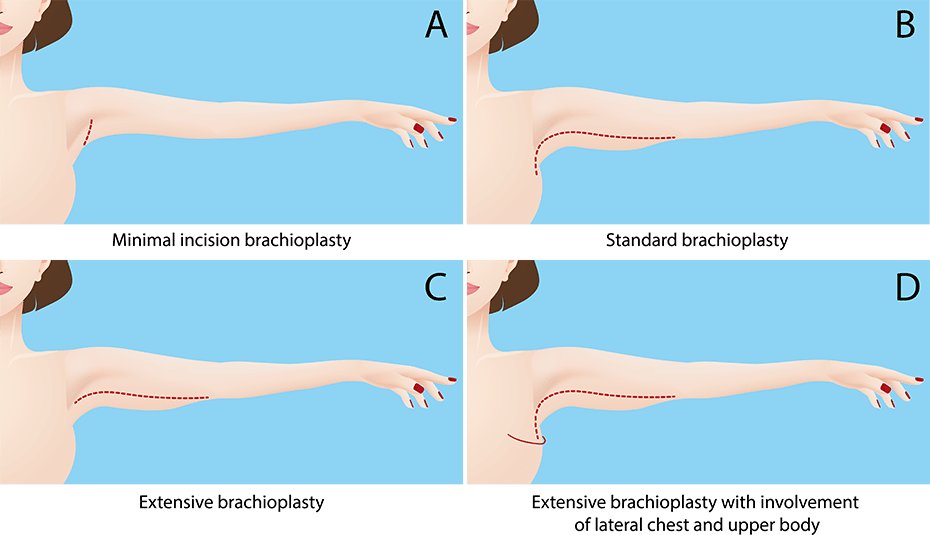

The skin laxity and excess that motivates most clients to undergo arm lift surgery can cause significant psychological and social distress. At The Harley Medical Group, we understand that this can be challenging in terms of self-esteem, body image, and forming and maintaining social relationships. Excess skin and fat around the upper arm can even cause pain and skin inflammation, impacting a client’s choice of clothing and reducing comfort levels.
Any procedure performed by surgeons at The Harley Medical Group incorporates a detailed initial assessment of the patient, their concerns, ideal results and thought processes leading up to the decision to seek surgical treatment, along with any other medical conditions they may have. Throughout the preoperative assessment, any decisions will be made in collaboration with the patient as part of a shared decision-making process.
Prior to arm lift surgery, your surgeon will examine the relevant areas, determine the amount of skin and fat that needs to be removed to achieve your goals, and advise you on the best options for treatment. Excess skin can be removed in different ways, and some techniques are able to place the scars in the armpit area where they are less visible. Excess fatty tissue can be removed by cutting it out or, more commonly, through liposuction at the same time.

On the day of the procedure, both the anaesthetic and surgical teams will assess the patient. Arm lift surgery can be performed under general anaesthetic or with sedation. This decision will be based on specific personal circumstances and the recommendations of the anaesthetic doctor.
Before the procedure, the surgeon will make precise, temporary markings on the skin of the arm and torso to plan the incisions and act as a guide for the contour changes that will be made.
Through a cut in the skin, the surgeon is able to carefully remove fat from underneath the skin and remove any loose excess skin to achieve taught, more youthful-looking contours.
Patients that undergo arm lift surgery are usually discharged home the same day, with a package of important postoperative advice.
After the procedure, the wounds will be dressed by the medical team and pain relief medications will be given to ensure as much comfort as possible. Compression garments will be applied and should be worn for at least 4 weeks unless advised otherwise by your surgeon.
Although you are likely to be allowed home on the same day as surgery, it is essential that all strenuous activity is avoided for at least 2 weeks to avoid disruption of the wound and encourage healing. Naturally, the range of motion of the arms will be reduced after surgery so driving must be avoided during the initial recovery period. It is important, however, to regain mobility as soon as is comfortable following general anaesthetic.
At approximately 1 week after surgery, you will be seen in clinic for the wounds to be assessed and any dressings will be changed or removed entirely. Although the follow-up appointment will be arranged for a week later, clients at The Harley Medical Group have access to postoperative support throughout the entire recovery journey, from Day 1.
Arm lift surgery is an excellent solution for those suffering from the impact of excess, loose skin on their self-confidence and body image. If you would like to find out more, you can explore whether arm lift surgery is the right option for you, view some of the impressive results achieved by our surgeons and find answers to some frequently asked questions.
Medically Reviewed April 2023, by Helena Antoniadou - Consultant Aesthetic Plastic Surgeon
If you are considering whether to undergo blepharoplasty or eyelid surgery, a detailed understanding of the relevant risks and potential complications is needed to make a well-informed decision. Getting older can take its toll on your appearance, particularly to the skin around the eyes which can become loose and wrinkled, start to sag, and make the eyes look tired, adding years to the face. This can negatively impact your self-esteem and even cause you to avoid social situations, if you are feeling like this then read on to find out how we can help.
Blepharoplasty, also known as eye bag removal or eyelid surgery, helps to restore youthfulness to the face and despite the name, this procedure helps to improve the appearance of the overall eye area.
During the consultation period with your surgeon, you will discuss your specific concerns and ideal outcomes. This period provides an opportunity for your surgeon to clarify your individual preferences to avoid any disappointment, and iron out any unrealistic expectations. This reduces the risk of appearing “overdone” or “overcorrected” which varies between individuals.
In the same way as any other surgical procedure, blepharoplasty is associated with some degree of risk and it is important that patients understand this before deciding to undergo treatment.
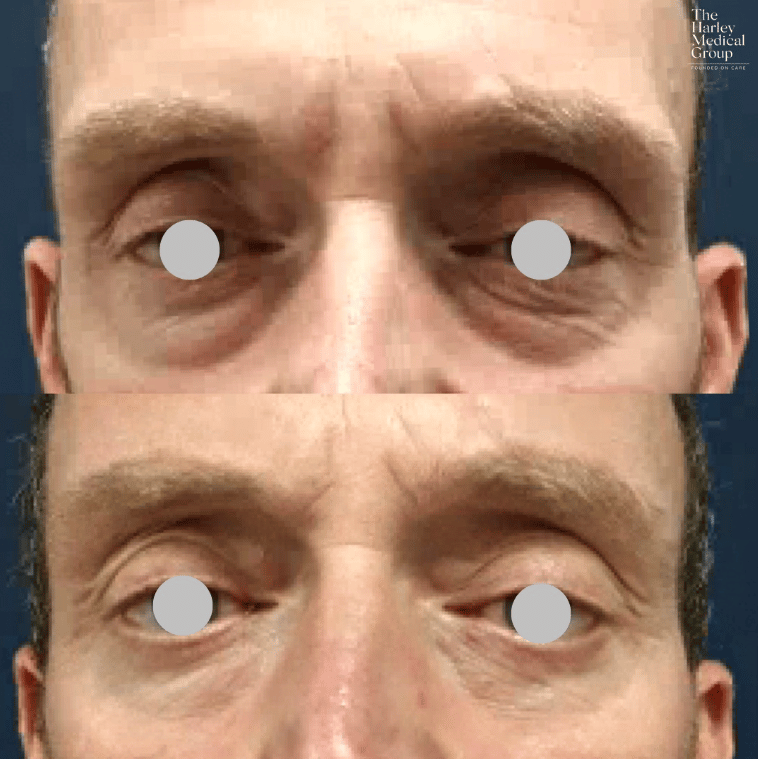
The surgical complications of eyelid surgery range from those that are minor to more severe, we will discuss a number of each in the next section of this article. To be clear, we understand that the perceived impact of any given complication will vary between clients, so your surgeon will discuss the likelihood of any complications in your personal circumstances.
Our surgeons complete extensive preoperative assessment processes, operate in the highest-quality clinical environments and have an unrivalled wealth of surgical training and experience, these are all factors that minimise the likelihood of surgical complications for the benefit of their patients. It is essential that when considering aesthetic surgery you select a reputable and regulated provider with appropriate experience and expertise in the relevant procedure.
At The Harley Medical Group, you will have the opportunity to view a gallery of before and after images from previous clients who have agreed to share the results of eyelid surgery procedures performed by your chosen surgeon.
Find out more on our Instagram
Given the site of surgery in blepharoplasty, there is a small risk of damage to the eye and subsequent visual disturbance. This is extremely rare, with a study in the Journal of Ophthalmic Plastic and Reconstructive Surgery finding that permanent vision loss occurred in 1 in 10,000 procedures2.
Interested in undergoing this procedure with us? Find out more about blepharoplasty at The Harley Medical Group.
Want to read more about this procedure? Ultimate Guide to Blepharoplasty Surgery
References
Looking into Blepharoplasty surgery? Find out more below.
As a consequence of the skin ageing process, volume loss, reduced elasticity and laxity are challenges experienced by everybody. The skin of the eyelids is no exception to the ageing process, which, unfortunately, can lead to the appearance of eyelid bags on the upper or lower lids. Many people also experience puffiness of the eyes due to excess fat and weakness of the muscles around the orbit.
Age-related changes to the structures around the eyes can be of significant cosmetic concern for our clients, not to mention the potential to cause problems with vision later down the line.
The features of the skin around the eyes make it particularly susceptible to the early phases of the ageing process. The skin in this area is thin, fragile, and often overlooked in many skincare routines. All of these features mean that the eyelids are unforgiving when it comes to staving off the signs of ageing.
If your reflection reveals saggy eyelid bags, puffiness or droopiness that age you beyond your years, or don’t align with your youthful vivacious mentality and approach to life, you have found the solution.
Eyelid surgery, or blepharoplasty, is a procedure involving adjustment and manipulation of the skin, fat and muscle of the eyelids. The procedure is capable of yielding significant cosmetic improvement to the face and providing a rejuvenated, youthful-looking appearance.

Blepharoplasty is often performed using a local anaesthetic or numbing agent. There is also the option to undergo a general anaesthetic in certain circumstances where this is required.
The process begins with a consultation with your chosen Harley Medical Group Plastic Surgeon. During this meeting, you will discuss your concerns and clarify your ideal results and preferences. This is where the patient-surgeon relationship begins, and this is a crucially important part of the process at The Harley Medical Group.
On the day of your procedure, your surgeon will re-examine the skin and other tissues around the eyes and place important markings on the skin for reference during the procedure. Next, a shield will be placed over the eye to protect it from damage during the operation. Any excess skin, fat or muscle tissue can then be adjusted or removed using a range of strategically placed cuts made by the surgeon. Blepharoplasty is an intricate and complex procedure requiring refined skill and extensive experience, both factors that your surgeon will utilise to achieve your desired results.
For a few weeks post-surgery, some patients might experience temporary irritation and sensitivity to the eyes and altered tear production, but this will usually settle down without the need for further action.
Find out more about Ms Helena Antoniadou
Eyelid surgery involves the permanent removal of excess tissues around the eyes. Whilst these tissues cannot regrow, the remaining skin will continue to age in the same way as in other areas of the body and no procedure can prevent this.
Depending on the age at which eyelid surgery is performed, upper lid results are expected to last upwards of 5-10 years, with lower lid results often persisting permanently.
Due to the incisions made during the procedure to remove the excess tissue, there will be scarring. Our surgeons make incisions along the naturally occurring lines in the skin to minimise the extent of scarring. Usually, incision scars fade over a period of up to 18 months, changing from deep red and purple initially, to pale pink and white over time.
If you are interested in exploring your options for eyelid surgery, you can arrange a no-obligation consultation with one of our patient advisors today. You can also view a range of results images from our existing clients and read more about the risks associated with blepharoplasty to inform your decision on whether to undergo treatment.
Find out more about blepharoplasty at The Harley Medical Group.
Want to read more?
Discover the risks of eyelid surgery and find out if it can affect your eyesight.
Introducing The Harley Medical Group guide to performing a self-examination for breast cancer symptoms. October is known globally as the month of Breast Cancer awareness. Whether you are one of the 55,000 women or 370 men diagnosed with breast cancer each year, have been impacted by breast cancer through a family member or friend, or have observed the life-changing effects of breast cancer in the media, it is important for us all to be breast aware.
October is the perfect time to improve your understanding of breast cancer, the associated signs and symptoms, and develop your self-examination technique. We are here to provide the guidance and education you need for a successful Breast Cancer Awareness Month and beyond.

In the UK, 1 in 7 females will be diagnosed with breast cancer during their lifetime.
Early diagnosis is key when it comes to improving breast cancer prognosis. When a breast cancer is detected whilst it is small and localised, the chance of successful removal is improved. In fact, 98% of women diagnosed with breast cancer at the earliest stage survive their disease for at least 5 years. When breast cancer is diagnosed later on, this is reduced to around 26%. You can read more about the importance of early diagnosis on the CRUK cancer intelligence pages.
Being breast aware is the best way to enable early detection. The only way to identify abnormal change is to be aware of what ‘normal’ means for your body. This means that it’s important to get to know your body and talk to your doctor as soon as possible if you notice something that doesn’t seem right to you. Performing a regular self-examination for breast cancer symptoms is an easy way for you to take control of your health.
In the UK, the NHS breast screening programme invites women between the ages of 50 and 70 for a mammogram every 3 years. Women over the age of 70 are also eligible for continued screening but will need to arrange this via your local breast clinic. Mammography is an excellent way to pick up internal changes in breast density, and other possible indicators of breast cancer. However, regular breast self-checking is essential in between mammograms to maximise the likelihood of changes being detected early.
When suspicious changes are noticed, a visit to the GP could either put your mind at ease or allow further exploration through referral to the specialist breast clinic.
At The Harley Medical Group we are committed to ensuring the health, safety and well-being of our clients, and have put together a simple guide to self-examination for breast cancer symptoms to help you familiarise yourself with what is normal for you and your body.
Although breast cancer incidence increases with age, it is never too early to begin familiarising yourself with your body through self-examination. The best time to do your monthly breast examination is about 3-5 days after your period finishes, depending on the cyclical changes to your breasts. You should examine your breasts consistently once a month, leaving a long enough gap to detect a change, but regularly enough to know what is normal for you. If you do not menstruate, you should examine your breasts on the same day each month. We recommend keeping a journal to record any natural changes in the breast.
If you experience any of the following signs or symptoms, visit your doctor to get them checked:
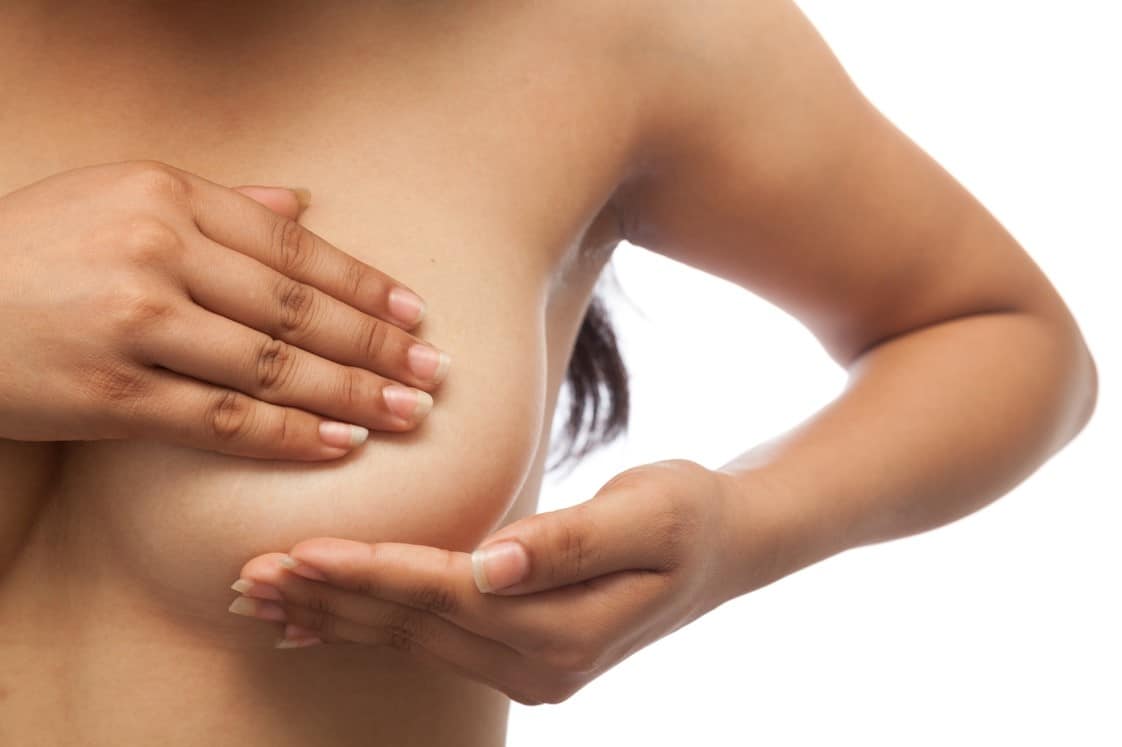
For many women, the most convenient place to examine their breasts is during or after a shower when they are undressed and can access a mirror.
A self-examination for breast cancer symptoms involves five steps:
IMPORTANT: Be sure to feel all the tissue from the front to the back of your breasts: for the skin and tissue just beneath, use light pressure; use medium pressure for tissue in the middle of your breasts; use firm pressure for the deep tissue in the back. When you've reached the deep tissue, you should be able to feel down to your ribcage.

Learn from our implant partner Macom's Marketing Director, Nadja, how to perform a self-examination for breast cancer.
https://www.instagram.com/p/CjauUvCqhPt/
If you are finding yourself struggling to breathe, feeling like your nose is blocked, or trouble sleeping, then you may need deviated septum surgery. The onset of Autumn brings Halloween, pumpkin patches, hues of red and orange, and pumpkin spice swiftly becomes part of all things food and drink. Alongside our favourite pastimes of the season come some autumnal challenges: worsening allergies, seasonal illness, respiratory triggers and flu to name a few.
World sinus health awareness day is an annual campaign designed to increase awareness of sinus illness and draw attention to the impact of nasal symptoms on sufferers. Chronic rhinosinusitis, or inflammation of the nasal cavity and sinuses, affects as many as 10% of UK adults. Symptoms including nasal congestion, repeated infection and facial ache can have a significant impact on quality of life, especially when treatments provide no relief.
An important and regularly treatable cause of nasal congestion is septal deviation. When the structures dividing the nasal cavity are misaligned, airflow can be obstructed leading to a sensation of blockage. This is often worsened during exercise and can be particularly disruptive during sleep.

If nasal obstruction is something that has affected you throughout your life or is a more recent consequence of injury or trauma to the nose, a surgical procedure called septoplasty can be performed to correct the deviation and restore the function of the nose. During this procedure, a specialist surgeon makes cuts in the internal lining of the nose to expose the underlying bone and cartilage. The surgeon is then able to make changes to the shape of these tissues.
If alongside your concerns around nasal airflow, the shape and appearance of your nose is a cause of self-consciousness, septoplasty can often be combined with nose reshaping surgery at The Harley Medical Group. A Septorhinoplasty procedure allows your surgeon to restore the functionality of the nose whilst making changes to the external contours to achieve your desired appearance.

Firstly, it is highly unlikely that NHS funding will be provided for any surgical procedure performed for purely cosmetic purposes. Whilst this probably does not come as a surprise, many patients assume that deviated septum surgery will be funded if their breathing is affected. However, there are a number of important considerations to be made:
Funding applications for combined septoplasty and rhinoplasty procedures are also rarely considered.
Eligibility for septoplasty is determined by several factors including the presence of obstructive symptoms, the cause of those symptoms and the extent to which surgery will improve symptoms and be of benefit to the patient.
If you are wondering how severe your symptoms are and whether surgery would be suitable in your circumstances, you can arrange a no-obligation consultation with one of our experienced Patient Advisors to discuss your concerns and explore your options.
In the meantime, you might find it useful to complete our sample of a questionnaire that is used commonly in practice to gauge the severity of obstructive symptoms:
Answer the questions below for an indication of how severe your nasal obstruction is:
How much of a problem have the following conditions been for you over the past month (0-4)?
Add together your score for each condition to give your total. This score is then multiplied by 5 to give the overall score
Septoplasty is most likely to be of benefit to those who score higher on this scale, with 81% of patients with severe obstruction experiencing improvement 12 months after surgery.
You can hear a patient’s perspective of septorhinoplasty below. Brandon, a patient at The Harley Medical Group underwent Septorhinoplasty with Mr Premjit Randhawa. Brandon was experiencing trouble with breathing which was affecting his confidence and disrupting his sleep, so decided to undergo deviated septum surgery.
You can also view a gallery of before and after images for Septorhinoplasty procedures performed by the experts at The Harley Medical Group for an insight into what can be achieved with this procedure. It is not only a deviated septum surgery, but for anyone concerned with the appearance of their nose.
Keen to read more about rhinoplasty surgery with The Harley Medical Group?
Choosing Surgical or Non-Surgical Rhinoplasty
Medically Reviewed April 2023, by George Samouris - Consultant Aesthetic Plastic Surgeon
Throughout the pregnancy process, the abdominal muscles can become stretched and separated due to progressive tension. This can also lead to stretching of the overlying skin. For some women, this is not an issue and represents a fond memory. However, many mothers feel that restoration of their pre-pregnancy body shape would reinvigorate their self-confidence. In some cases, your skin may snap back as it once was, but most people may be left with loose skin on your tummy.
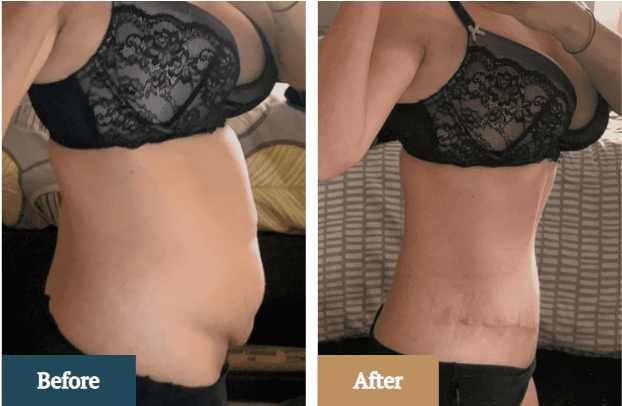
It is no surprise then that one of the most common indications for tummy tuck surgery is the changes that occur during pregnancy, but is this complicated by caesarean section deliveries?
The answer to the question ‘can I have a tummy tuck after a c-section?’ is a resounding yes, and a tummy tuck will not only help to remove excess skin, and repair and tighten the abdominal muscles but may also help to improve the appearance of the c-section scar.
See one of our lovely patients before & afters
You may have read about the concept of undergoing tummy tuck surgery at the same time as a c-section. This procedure is requested by some women to combine the two and avoid future surgery. However, a study published in Aesthetic Plastic Surgery found that c-section combined with abdominoplasty increases the risk of complications and does not provide the desired cosmetic outcome for the patient.
In order the achieve the best possible results from abdominoplasty, a sufficient amount of recovery time must be allowed between the c-section and tummy tuck surgery. This recovery period ranges from 6 to 12 months and will ensure that the c-section scar is properly healed, any bruising or swelling has resolved and also allows enough time for the body to return to the pre-pregnancy shape.
We understand that many women will be anxious to undergo tummy tuck surgery as soon as possible following a c-section. However, it is essential that the body is afforded the time it needs to recover from not only invasive c-section surgery, but the pregnancy itself.
If you are considering tummy tuck surgery after a c-section, our expert surgeons at The Harley Medical Group are available to discuss your desired results and personal circumstances. As well as allowing your body to heal physically following pregnancy and c-section, it is important to consider the impact that abdominoplasty will have on your activity and ability to interact with and take care of your child.
At The Harley Medical Group, we will work with you to find the best solution for your needs, and can offer either a full tummy tuck or a mini tummy tuck depending on your desired outcome. Following your surgery, you will have a scar, but this will sit along the bikini line, lower on the body than a Full Abdominoplasty scar. A Mini Tummy Tuck scar will also be smaller, only a little larger than a C-Section scar, rather than the traditional hip-to-hip incision.
Abdominoplasty is most suitable for those with excess abdominal fat and loose skin. Unfortunately for many, even the most dedicated lifestyle changes in diet and exercise cannot remove loose skin or stubborn pockets of fat.

Tummy tuck surgery is not a weightloss solution and patients are required to be of stable body weight and in good physical health before undergoing the procedure.
It is also important that patients are undergoing surgery for the right reasons and the operating surgeon will discuss your rationale to gain an understanding of your motivation for choosing to have a tummy tuck after a c-section.
Find out from Mr George Samouris what happens during the consultation process with him. He is keen believer of patient centred care and works with his patients to obtain the best personal aesthetic outcome for the individual. He has published his studies in many renowned international journals and has given many lectures on domestic and international medical conferences. With countless amazing results and reviews from his many patients, you can be sure that you are in the safest possible hands.
If you are considering a tummy tuck after a c-section, you can find out more about the procedure, view results and explore the costs. You can also discuss any questions relating to your personal circumstances during a free no-obligation consultation with a Patient Advisor at The Harley Medical Group.
Choice is always a good thing, it means that you can make the right decisions for you, based on your needs and your desired result. At The Harley Medical Group, we will never perform a surgery if we do not believe it is right and there is never any pressure to book in with us. Cosmetic surgery is an important decision and we want to support you, regardless of your choices. If you're not sure that a tummy tuck after a c-section is right for you, we also offer other Body Contouring procedures which could help you achieve your desired results such as vaser liposuction.
If you'd prefer something less invasive than a tummy tuck after a c-section, try our body contouring and weightloss treatments at our clinic partners sk:n. We offer radiofrequency treatments, fat freezing, cellulite treatments which all break down fat cells, and Mediweight which can aid weightloss either before a surgical procedure, or as an alternative.
Medically Reviewed April 2023, by George Samouris - Consultant Aesthetic Plastic Surgeon
If you are wondering 'is a tummy tuck safe' and if surgery is for you, you will need more information about the procedure to make your decision. Here we will be covering the details of abdominoplasty (tummy tuck) safety, including side effects, risks and potential complications.
See some life-changing tummy tuck patient results on our Instagram

As with any surgical procedure, it is important to consider the associated risks alongside the potential benefits that the treatment can offer.
So, is a tummy tuck safe? The specifics vary depending on the type of abdominoplasty performed, but a study published in the Journal of Plastic and Reconstructive Surgery found that complications occur in just 4% of cases overall.
So what are the potential complications?
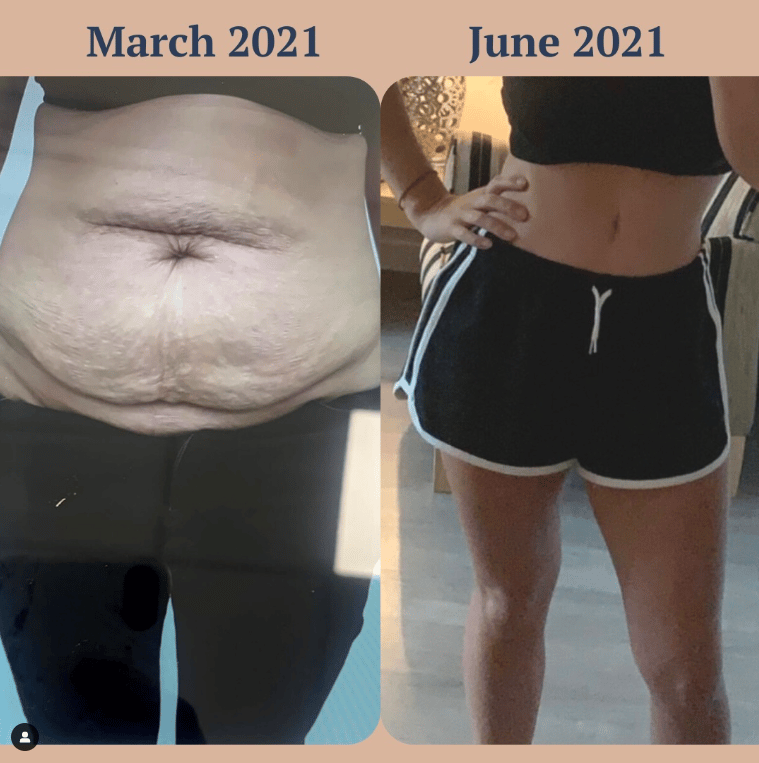
There is always an element of risk that comes with undergoing tummy tuck surgery, this is in part due to the surgery itself as well as the anaesthetic. The best method of preventing complications is to choose an experienced, skilled and appropriately regulated surgeon. This will ensure that the procedure is carried out in the safest possible way.
In addition to your choice of surgeon, there are some choices you can make in preparation to reduce complication risk:
Do:
Don’t:
Expert Recovery Tip: After surgery, it is important to get moving as soon as possible. As soon as you feel able to, get out of bed and take a short walk to promote blood flow and prevent clot formation.
If you would like to explore how abdominoplasty can help you to restore confidence in your appearance, you can read more about the procedure, the associated costs, our expert surgeons, or book a no-obligation consultation with one of The Harley Medical Group Patient Advisors here. We hope you are reassured if you were wondering 'is a tummy tuck safe?'
Medically Reviewed April 2023, by George Samouris - Consultant Aesthetic Plastic Surgeon
What is a tummy tuck? Are you longing to remove that excess skin that won’t shift after significant weight loss or pregnancy? We have the solution. Abdominoplasty (or tummy tuck surgery) is one of the most popular cosmetic plastic surgery procedures for both men and women. In this article, we will cover the details of the procedure, an overview of the recovery process and bust a myth or two.
During this procedure, a relatively large incision is made across the trunk from hip to hip in the bikini line. Incisions may also be made around the belly button and possibly vertically along the trunk if necessary. These incisions are made to enable the surgeon to remove the excess skin along with a small amount of underlying fat tissue. This technique results in tightened, refined abdominal contours.

Every patient is unique, and so are their reasons for choosing abdominoplasty. But the procedure is most suitable for those seeking to improve the aesthetic of their abdomen, remove excess skin following weight loss, or strengthen the abdominal muscles after multiple pregnancies.
A less invasive alternative to abdominoplasty is mini tummy tuck surgery. In this procedure, a single incision is placed in the lower abdomen, just below the waistline. The incision is smaller than in full abdominoplasty and is, therefore, more easily concealed and can even be undetectable after the full recovery period.
Operating times vary according to individual circumstances but usually range from 2 to 5 hours. The surgery is performed under general anaesthetic so you will be asleep for the duration of the treatment.
Both abdominoplasty and mini abdominoplasty are examples of major surgery that require lengthy recovery periods and often a short stay in hospital. The procedure itself is complex and is founded on sophisticated surgical principles that take decades to master. As a result of this, choosing to undergo surgery should be an investment in both the aesthetic result and safety. At The Harley Medical Group, abdominoplasty is performed by experienced Consultant Plastic Surgeons in the highest quality private hospital facilities. Clients at The Harley Medical Group invest upwards of £7,700 for full abdominoplasty and £6,125 for mini tummy tuck surgery.
For the reasons mentioned above, low-cost invasive surgery should set alarm bells ringing and you should always conduct your own research into the treatment provider and the operating surgeon.
Generally, the recovery process following abdominoplasty takes between 6 and 8 weeks and involves rest, avoidance of strenuous activity and adherence to a compression garment schedule. You can read our detailed blog post on the tummy tuck recovery process here.

Immediately after surgery, the incisions will be covered with dressings. The incision healing process takes 1-2 months. It is important to adhere to the aftercare instructions provided by your Surgeon and Nurse Counsellor regarding compression and wound care to optimise healing.
Abdominoplasty is designed to remove excess skin from around the abdomen. While sometimes a small amount of excess fat is also removed, weight loss is not the desired outcome. The ideal candidate for abdominoplasty is of normal weight and is physically healthy.
Yes, abdominoplasty is common among females, but many males choose to undergo tummy tuck surgery after weight loss to tighten the abdominal muscles and achieve a flatter, more toned appearance.
Want to see more patient results with a tummy tuck? Follow our Instagram now.
Medically Reviewed April 2023, by Premjit Randhawa - Consultant Aesthetic Rhinoplasty Surgeon
Here we are taking a deep dive into the key differences between nose treatments, so you can choose from a surgical or non-surgical rhinoplasty procedure. Nose reshaping, or rhinoplasty, is an increasingly popular cosmetic procedure and with the introduction of non-surgical techniques, is becoming more and more accessible.

To choose between surgical or non-surgical rhinoplasty, you need to know the difference between these treatments. Surgical Rhinoplasty involves making incisions in the skin and making changes to the shape of the bone and cartilage in the nose. Non-surgical rhinoplasty offers a less invasive alternative to surgical interventions for those searching for a way to correct, enhance or alter the shape and appearance of the nose. Dermal fillers are injected under the skin in specific locations to alter the proportions and contours of the nose to give the illusion of a thinner, straighter or more symmetrical appearance.
At our sister company sk:n, only qualified medical practitioners carry out our injectable treatments so you can rest assured you are in safe hands.
As with any aesthetic procedure, there are pros and cons that make the different options more suitable for some patients than others.
Non-surgical techniques provide solutions that are less costly, associated with fewer risks and require shorter recovery periods. Whereas surgical facilitates a more drastic, permanent change to the shape of the nose.
The nature of surgical Rhinoplasty means that it is associated with greater risk than non-surgical, especially when performed under general anaesthetic. A study published in The Aesthetic Surgery Journal found that the overall complication rate of surgical Rhinoplasty was 0.7%[1] and some of the risks include:
Non-surgical rhinoplasty is considered to be safe and complications are rare but there is a risk of swelling, bruising and redness around the injection sites. A safety review published in The Journal of Facial Plastic Surgery and Aesthetic Medicine found that serious events occur in just 0.2% of cases when administered by a Doctor[2].
Nose fillers are a series of small injections of gel which will are applied to the soft tissue in the nose to shape, straighten and contour. Injecting the dermal filler takes less than half an hour and the results will not only be instant, but last around 12 months.
Surgical is most suitable for patients who are searching for a permanent solution to their cosmetic concerns and where more significant changes are required. Non-surgical rhinoplasty is a suitable alternative for many patients looking to make minor adjustments to the contours of the nose or smoothen small bumps and irregularities.
However, there are circumstances where it would not be possible to achieve a patient’s desired results with non-surgical Rhinoplasty. Some examples of when this might be the case include:
In these cases, surgical intervention may be more appropriate. In any instance, the most suitable approach for your aesthetic goals should be discussed with your expert at The Harley Medical Group during a free no-obligation consultation. You can read about the most important questions to ask your Rhinoplasty surgeon here.
If you would like to explore how non-surgical Rhinoplasty can help you to achieve your desired results, sk:n, the UK’s leading skin clinic, provides non-surgical nose job treatments administered by highly trained and experienced expert clinician injectors. Together, we hope to help you make the right decision about whether to choose surgical or non-surgical rhinoplasty.
Discover Brandon's rhinoplasty surgery journey with Mr Premjit Randhawa;
Sources:
1. Layliev J, Gupta V, Kaoutzanis C, Ganesh Kumar N, Winocour J, Grotting JC, Higdon KK. Incidence and Preoperative Risk Factors for Major Complications in Aesthetic Rhinoplasty: Analysis of 4978 Patients. Aesthet Surg J. 2017 Jul 1;37(7):757-767. doi: 10.1093/asj/sjx023. PMID: 28472446.
2. Rivkin A. Nonsurgical Rhinoplasty Using Injectable Fillers: A Safety Review of 2488 Procedures. Facial Plast Surg Aesthet Med. 2021 Jan-Feb;23(1):6-11. doi: 10.1089/fpsam.2020.0291. Epub 2020 Dec 2. PMID: 33270519.